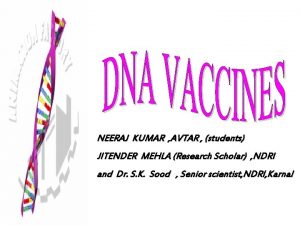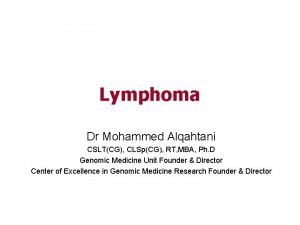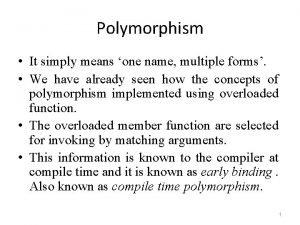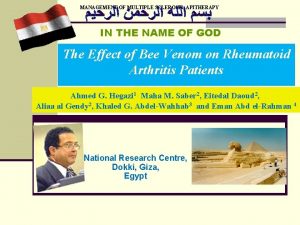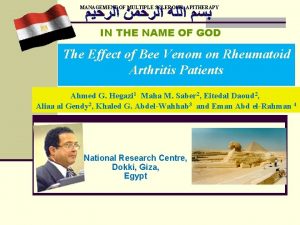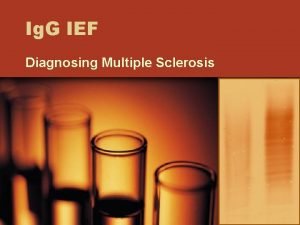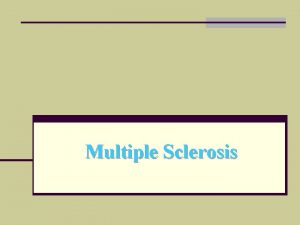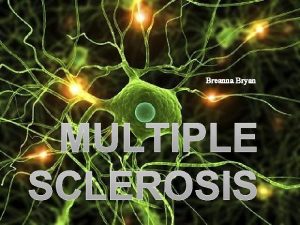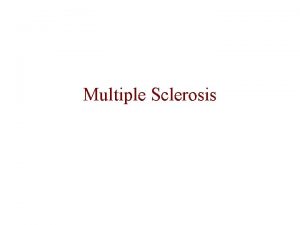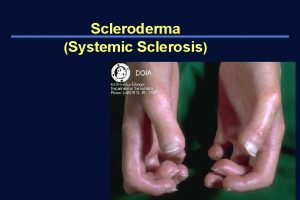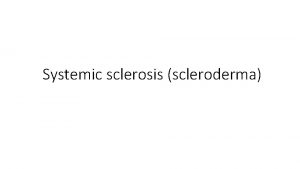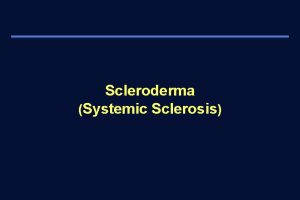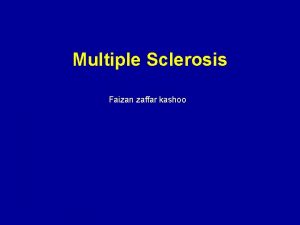MANAGEMENT OF MULTIPLE SCLEROSIS APITHERAPY IN THE NAME




































- Slides: 36

ﺑﺴﻢ ﺍﻟﻠﻪ ﺍﻟﺮﺣﻤﻦ ﺍﻟﺮﺣﻴﻢ MANAGEMENT OF MULTIPLE SCLEROSIS: APITHERAPY IN THE NAME OF GOD Evaluation of antibacterial activity of some Egyptian and Saudi Arabia honeys Ahmed Hegazi; Eman H. Abdel- Rahman and Ehab Fouad National Research Center, Dokki, Giza, Egypt

Evaluation of antibacterial activity of some Egyptian and Saudi Arabia honeys

The bilogy of honey bee(apis mellifera) Kingdom: animalia Phylum: arthropoda Class: insecta Family: apidae Genus: apis Species: apis mellifera Apis mellifera(honey bee)

Historic Record • Humans eventually began providing cavities for honey bees to nest in. • Earliest records are Egyptian


Egyptian beekeeping Harvesting honey combs (right) and packing honey (left) ca. 1450 BC, West Bank, Luxor

Honey • In ancient Egypt, honey was used to sweeten cakes and biscuits, and was used in many other dishes. • The fertility god of Egypt, Min, was offered honey (Hegazi, 2012).

Definition • Honey is a sweet food made by bees using nectar from flowers. • The variety produced by honey bees (the genus Apis) • Honey bees transform nectar into honey by a process of regurgitation and evaporation. • They store it inside the bee hive (The National Honey Board, 2003).

Honey • Honey is one of the oldest medicines. • Its use is recorded in Egyptian papyri dated from 1900 to 1250 B. C. • used many of the Egyptian prescriptions They found that honey "cleans sores and ulcers of the lips, heals carbuncles and running sores

Religious significance • In Islam, there is an entire Surah in The Holy Qur’an called an-Nahl (the Bee). • According to Hadith, Prophet Muhammad strongly recommended honey for healing purposes (Sahih Bukhari). • The Qur'an promotes honey as a nutritious and healthy food. ﴾ ﻯ ﻥ ٱﻠ ٱﻯ ﺍ ﻥ ﻭﺍ ﺍ ۥ ﻳ ﻟ ﺍ ﻯ ٦٨﴿ • “ﻯ ﻯ ٱﻠ ٱ ﻯ ٱﺍ ﻭﺍ ٱﻠ ﺍ ﻭ ﴾٦٩﴿ ” ﺍ ﻭ

Honey composition: Component Average (%) Moisture 17. 2 Fructose 38. 19 Glucose 31. 28 Sucrose 1. 31 Disaccharides, calculated as maltose 7. 31 Higher sugars 1. 5 Free acid as gluconic 0. 43 Lactone as Gluconolactone 0. 14 Total acid as gluconic 0. 57 Ash 0. 169 Nitrogen 0. 041 Data was collected from 490 samples of US honey (White et al. , 1962).

y t i v i t c a l a i r e t c a b i t n A

Evaluation of antibacterial activity of honey: • Both bacteriostatic and bactericidal effects have been reported for many strains, • Honey has been reported to have an inhibitory effect to around 60 species of bacteria including aerobes and anaerobes, grampositives and gram- negatives (Molan, 1992).

Bacterial strains: Six bacterial species included Gram positive and Gram negative were used. The Gram positive bacteria were Staphylococcus aureus (ATCC 25923), Streptococcus pyogenes Corynebacterium pseudotuberculosis.

Gram negative bacteria • Klebsiella pneumonia (AT CC 27736), • Pseudomonas aeruginosa (AT CC 27853) • • Escherichia coli (AT CC 35218)

Honey samples • Fresh samples provided from flowering season • They were mono floral honeys harvested from apiaries • (From Authorized apiary farm).

Egyptian honey samples • • acacia honey, citrus honey, clover honey, coriander honey, cotton honey, palm honey sesame honey

Saudi honey sample • sider honey, • was kindly provided by El. Yahia Company 2004,

s t l u s Re

Fig. 1: Antibacterial activity of different honey types against Gram positive bacteria.

Fig. 2: Antibacterial activity of different honey types against Gram negative bacteria.

The antimicrobial activity of twelve Saudi honey samples was investigated against 6 bacteria belonging to Gram positive and Gram negative bacteria.

The Gram positive bacteria were • Staphylococcus aureus • (ATCC 25923), • Streptococcus pyogenes • Corynebacteria pseudotuberculosis.

Gram negative bacteria were • Klebsiella pneumonia (ATCC 27736), • Pseudomonas aeruginosa (ATCC 27853) • Escherichia coli (ATCC 35218).

Honey samples • • • Sidr or birds or Sidr North honey Tabah honey Rok honey spring Lena honey Harbingers honey Valley offense (Qtad) honey

Honey samples • • • Abu roses honey spring hospitality honey Agaa mount honey Spring honey pride, then Sair honey Hegaz Spring honey Shamar mount honey

• Honey samples were kindly obtained from Sh. Fayez Al Gethamy • Al Nahal Al Gawal Apery farm

s t l u s Re



C n o s u l c n io

Conclusion • Honey samples were obtained from 20 (8 Egyptian and 12 Saudi) different floral sources. • The findings indicate that honey samples with different Egyptian and Saudi honeys, were effective antibacterial against different pathogenic bacteria.

Conclusion • The results showed also that most of honey samples at 20. 30 % (w/v) can completely inhibit the growth of all of the tested bacteria. • It was clear that the different types of honey were less effective against E. coli than other bacteria.


Evaluation of antibacterial activity of some Egyptian and Saudi Arabia honeys

Evaluation of antibacterial activity of some Egyptian and Saudi Arabia honeys
 Is multiple sclerosis fatal
Is multiple sclerosis fatal Multiple sclerosis nursing concept map
Multiple sclerosis nursing concept map Virus multiple sclerosis
Virus multiple sclerosis Concept map for disease process
Concept map for disease process Zita vas
Zita vas Tuximab
Tuximab Hodgkin lymphoma nodular sclerosis
Hodgkin lymphoma nodular sclerosis Draw three noncollinear points j k and l
Draw three noncollinear points j k and l Multiple baseline across settings
Multiple baseline across settings Multiple instruction multiple data
Multiple instruction multiple data Means one name, multiple forms.
Means one name, multiple forms. Hình ảnh bộ gõ cơ thể búng tay
Hình ảnh bộ gõ cơ thể búng tay Lp html
Lp html Bổ thể
Bổ thể Tỉ lệ cơ thể trẻ em
Tỉ lệ cơ thể trẻ em Chó sói
Chó sói Tư thế worms-breton
Tư thế worms-breton Chúa sống lại
Chúa sống lại Kể tên các môn thể thao
Kể tên các môn thể thao Thế nào là hệ số cao nhất
Thế nào là hệ số cao nhất Các châu lục và đại dương trên thế giới
Các châu lục và đại dương trên thế giới Công thức tính thế năng
Công thức tính thế năng Trời xanh đây là của chúng ta thể thơ
Trời xanh đây là của chúng ta thể thơ Mật thư tọa độ 5x5
Mật thư tọa độ 5x5 Phép trừ bù
Phép trừ bù Phản ứng thế ankan
Phản ứng thế ankan Các châu lục và đại dương trên thế giới
Các châu lục và đại dương trên thế giới Thể thơ truyền thống
Thể thơ truyền thống Quá trình desamine hóa có thể tạo ra
Quá trình desamine hóa có thể tạo ra Một số thể thơ truyền thống
Một số thể thơ truyền thống Bàn tay mà dây bẩn
Bàn tay mà dây bẩn Vẽ hình chiếu vuông góc của vật thể sau
Vẽ hình chiếu vuông góc của vật thể sau Nguyên nhân của sự mỏi cơ sinh 8
Nguyên nhân của sự mỏi cơ sinh 8 đặc điểm cơ thể của người tối cổ
đặc điểm cơ thể của người tối cổ Ví dụ giọng cùng tên
Ví dụ giọng cùng tên Vẽ hình chiếu đứng bằng cạnh của vật thể
Vẽ hình chiếu đứng bằng cạnh của vật thể Vẽ hình chiếu vuông góc của vật thể sau
Vẽ hình chiếu vuông góc của vật thể sau


